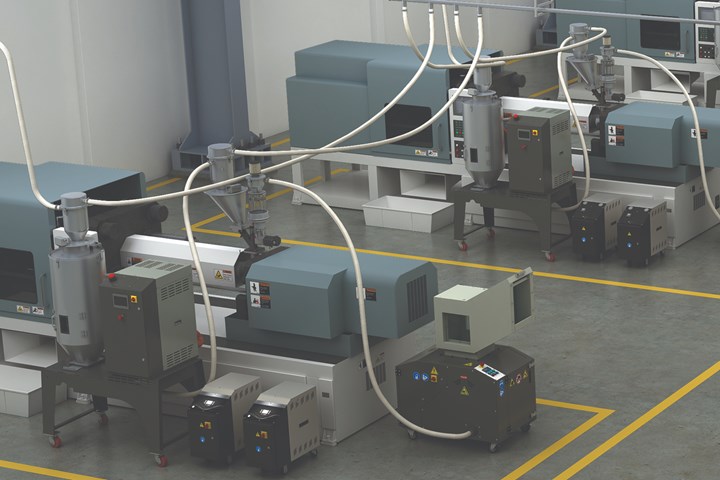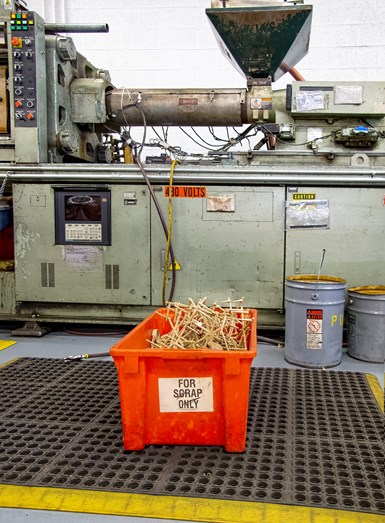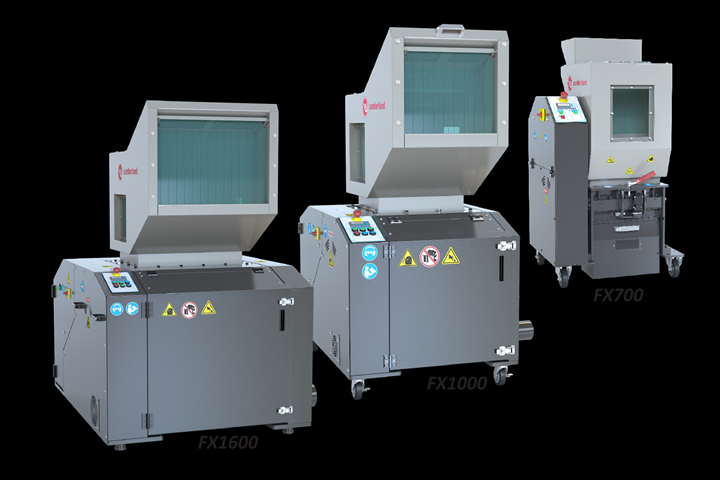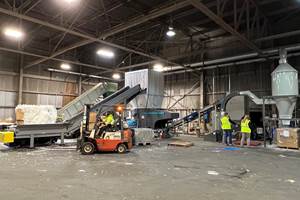No matter what type of process is the mainstay of your plastics manufacturing operation, every floor manager knows that waste materials generated can be significant. Ideally, those materials are reclaimed back into the process. By grinding the plastic materials down to a size that’s similar to the virgin material, you drastically decrease waste and use less of that new material in the process.
Regardless of the size of your operation or type of manufacturing process, regrinding of plastic components has the potential to create substantial savings. There are multiple types of size-reduction equipment, including shredders and granulators that can be used to transform the material into a more useable state. The type of machines utilized in a process depend on the material characteristics, size and density. Considering the annual savings over many manufacturing runs, it’s vital that you choose the right type of granulator based on your particular processing operation, type of materials, labor, floor and storage space, and many other factors.
To help get the most from regrinding, plastics processors typically use one of two types of manufacturing-floor configurations and equipment designed for that workflow: a central granulator or a beside-the-press granulator. (It should be noted that Under-the-Press [UTP] granulators are sometimes categorized with beside-the-press granulators, although they are generally located beneath a thermoforming line.) Each approach to regrinding has pros and cons that are specific to each operation, so the burden is on floor managers and manufacturing engineers—with the help of a knowledgeable equipment partner—to determine what works best to meet the company’s needs, limitations, and goals.

Injection molding plant equipped with beside-the-press granulators.
Although a central granulator configuration offers many benefits for those operations that are well-suited for that equipment, this article will focus on beside-the-press (BTP) granulators. We’ll explore the top reasons you might want to choose this type of granulator for your plastic component waste, as well as other considerations.
A beside-the-press granulator is an ideal solution for maximizing your floor space.
REASON 1: Material Savings
Depending on your current floor operations, selecting a beside-the-press configuration may result in substantial materials savings for several reasons. First, by their very nature, beside-the-press granulators offer a tailored solution for the most usable reclaim. It’s vital to work with your equipment supplier to ensure that you determine the best chamber geometry for your applications and type of material. You also want to consider the size of the discharge bin: A larger bin allows for more uptime, which decreases the frequency of bin emptying. When vacuum-takeoff (VTO) is used, a larger bin helps create a buffer for surges in granulator discharge rates.
Second, the beside-the-press granulator can reduce material loss due to inefficient material handling and machine cleanout. While central granulators have their place in many operations, BTP granulators have the benefit of direct throughput from the press, eliminating the need for excessive manual handling and cleanouts that can result in material waste. BTPs can be fed by hand or robot at the press.
Third, regrind materials can be fed directly from the granulator takeoff back into the primary process. This might include an equipment configuration with an evacuation system that sends regrind material back into the process line. It can be completely automated, eliminating manual processes and the resulting material losses and leakage.

Granulating scrap beside the press, instead of at a central location, minimizes handling, storage and possible contamination.
REASON 2: Labor Savings
Beside-the-press granulators eliminate the need to collect, store, and process batches in a central granulator workflow. For example, a typical central granulator process might include dedicated personnel responsible for:
• Collecting materials to regrind;
• Depositing them in gaylords;
• Using a forklift to move the gaylords to a dedicated central granulation room;
• Regrinding the materials there using a central granulator;
• Depositing the ground materials back into gaylords; and
• Forklifting ground materials back into the production facility for reuse, or transporting them back to storage (onsite or offsite)
Obviously, all these manual tasks—done repeatedly—present a layer of complexity and increase labor costs. For operations where a beside-the-press granulator is the best fit, the benefits may include an immediate decrease in operational costs without the constant need to handle and transport regrind materials.
REASON 3: Increased Production Floor Space
In today’s competitive environment, square footage on the production floor comes at a premium. A BTP granulator is an ideal solution for maximizing your floor space.
With a beside-the-press granulator, you can increase production capacity. This gives you the ability to replace former storage space with potential additions to production floor space. The net effect is increased production capacity where material storage previously took place.
 Beside-the-press granulators are available in a variety of sizes and configurations. Each machine integrates into any molding or extrusion operation for resin reclaim directly at the side of the primary machine
Beside-the-press granulators are available in a variety of sizes and configurations. Each machine integrates into any molding or extrusion operation for resin reclaim directly at the side of the primary machineAlso, you’ll benefit from less storage or material to be processed, as well as decreased storage of regrind material after processing.
REASON 4: Less Maintenance
With a BTP granulator, the frequency of machine cleanout is minimized because each unit is typically dedicated to one production line. With a central granulation process, the system may need to be cleaned out multiple times a day with material changes from multiple lines. Plus, newer well-designed BTP models can permit accelerated total machine cleanout due to increased accessibility to the cutting chamber. The potential benefit may make machine cleanout up to six times faster.
Also, today’s premium BTP models feature high-quality knives and screens that have increased longevity, reducing consumable parts and decreasing variable operating cost. It’s not uncommon for new granulators to run for well over a year with the original knives and screens and zero downtime. Generally, the knife and screen kits for each BTP granulator are selected for regrinding a specific type of material. This specificity results not only in greater performance but greater uptime and less maintenance.
REASON 5: Increased Safety
Safety during servicing is important. Features such as rotor lock; safety interlocks to access the chamber; hopper and chamber lift assist; tipping prevention; and other key features are recommended with any granulator installation. Industry-leading companies use a variety of interlocks to ensure that service work can be done safely:
• Zero rotor-speed detection prevents users from accessing the cutting chamber until the rotor has stopped;
• Hopper lock automatically engages with manual disengagement;
• Rotor lock automatically engages with manual override;
• Chamber lock ensures that the upper chamber is locked via solenoid-activated interlock;
• Discharge-bin lock operates via solenoid-activated network.
Currently, the gold standard for granulator safety is ISO 12100 and Category 3 requirements. This requires that the equipment conforms to the principles of risk assessment and has two sets of redundant safety interlock circuits so that a single fault does not lead to the loss of the safety function. Safety-rated components and reliability are also part of these requirements.
The fewer tasks involved with unloading, cleaning, retooling knives or screens, or any other internal workings of a granulator, the safer your operation.
Plastic manufacturing operations with BTP size reduction will naturally reduce injury risks and increase safety overall by minimizing manual handling of material. Decreased maintenance of knives and screen components mentioned above is also a factor that keeps employees safe. Simply put, the fewer tasks involved with unloading, cleaning, retooling knives or screens, or any other internal workings of a granulator, the safer your operation.
Poor service on a granulator can result in poor-quality regrind with excessive dust and fines. So, accessibility to the cutting chamber, rotors and knives is extremely important. Knives must be kept sharp and clean for best results, and the cutting gap between rotating and stationary knives should be easy to set and maintain. Ease of cleaning is also important, particularly in short-run environments where the granulator must be thoroughly cleaned before moving on to the next material.
Finally, harmful high sound levels are another layer of safety risks every operation must consider as they look to decrease the liability of hearing loss of employees. Not surprisingly, most of the sound generated by a granulator occurs in the cutting chamber. But significant noise can be generated by the drive train as well. A full sound enclosure is designed for maximum noise suppression and will typically lower the decibel level outside the machine by 10% to 30%.
When determining the right beside-the-press granulator for your facility, look for sound-damping features that help make your operation quieter, safer, and more enjoyable for your employees.
ABOUT THE AUTHOR: Andre Adams is the senior product manager for size reduction and material handling at ACS Group. Prior to his current role, Adams spent 15 years as a lead mechanical engineer and product manager for Centrisys Corp. in the water/wastewater reclamation industry. At ACS, he has helped shape and develop strategies for plastics sustainability and circular-economy initiatives. He has worked extensively with key partners such as KW Plastics and Teel Plastics to construct modeling systems, case studies, and white papers to quantify net benefits and best practices that favorably impact profitability. Contact: 262-641-8600; aadams@acscorporate.com; cumberlandplastics.com
Related Content
Recycled Material Prices Show Stability Heading into 2023
After summer's steep drop, most prices leveled off in the second half.
Read MoreRecycling: What's Ahead in Advanced Sorting Technology
As the industry tries to ramp up recycling, there are several innovative sorting solutions in the offing—ranging from enhanced optical sorting technologies and chemical tracers to advanced solutions based digital watermarks and artificial intelligence.
Read MorePurpose-Built System Enhances Capacity and Flexibility for Recycler
A Boston recycler invested in a turnkey shredding, granulation and elutriation system to expand its plastics reclaim business.
Read MoreScaling Up Sustainable Solutions for Fiber Reinforced Composite Materials
Oak Ridge National Laboratory's Sustainable Manufacturing Technologies Group helps industrial partners tackle the sustainability challenges presented by fiber-reinforced composite materials.
Read MoreRead Next
Lead the Conversation, Change the Conversation
Coverage of single-use plastics can be both misleading and demoralizing. Here are 10 tips for changing the perception of the plastics industry at your company and in your community.
Read MoreAdvanced Recycling: Beyond Pyrolysis
Consumer-product brand owners increasingly see advanced chemical recycling as a necessary complement to mechanical recycling if they are to meet ambitious goals for a circular economy in the next decade. Dozens of technology providers are developing new technologies to overcome the limitations of existing pyrolysis methods and to commercialize various alternative approaches to chemical recycling of plastics.
Read More





























